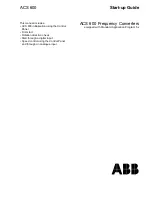
HV100 Series High Performance Current Vector Inverter
116
0: General model
1~4: Reserved
LED ten bits: Broadcast frequency source selection
0: Host set frequency
1: Host frequency source A
2: Host frequency source B
LED hundred bits: Reserved
LED thousand bits: Reserved
11.08
Communication display selection
0000
~
4444
000
LED bits: Communication bus voltage display selection
0: Normal display
1: Magnify 10 times
2: Magnify 100 times
3:Shrink 10 times
4:Shrink 100 times
Led ten bits: Communication current display selection
0: Normal display
1: Magnify 10 times
2: Magnify 100 times
3:Shrink 10 times
4:Shrink 100 times
LED hundred-digit: Operation frequency display selection
0: Normal display
1: Magnify 10 times
2: Magnify 100 times
3:Shrink 10 times
4:Shrink 100 times
LED thousand bits: Reserved
012 Group -Advanced functions and performance parameters
12.00
Energy consumption braking function setting
0
~
2
1
0: Invalid
1: Valid in the whole process
2: Valid only when decelerating
12.01
Energy consumption braking starting voltage
220V:340
~
380V
360V
380V:660
~
760V
680V
Model setting
12.02
Energy consumption braking return difference voltage
220V:10
~
100V
5V
380V:10
~
100V
10V
Model setting
12.03
Energy consumption braking action ratio
10
~
100%
100%
The above function codes are used to set the voltage threshold value, return difference voltage value and brake unit
utilization rate of the built-in brake unit of the inverter. If the internal DC side voltage of the inverter is higher than the
starting voltage of energy consumption braking, the built-in braking unit will act. If a braking resistor is connected at this
time, the internal pumping voltage energy of the inverter will be released through the braking resistor to reduce the DC
voltage. When the DC side voltage drops to a certain value (starting voltage-brake backlash), the built-in brake unit is
turned off.
















































